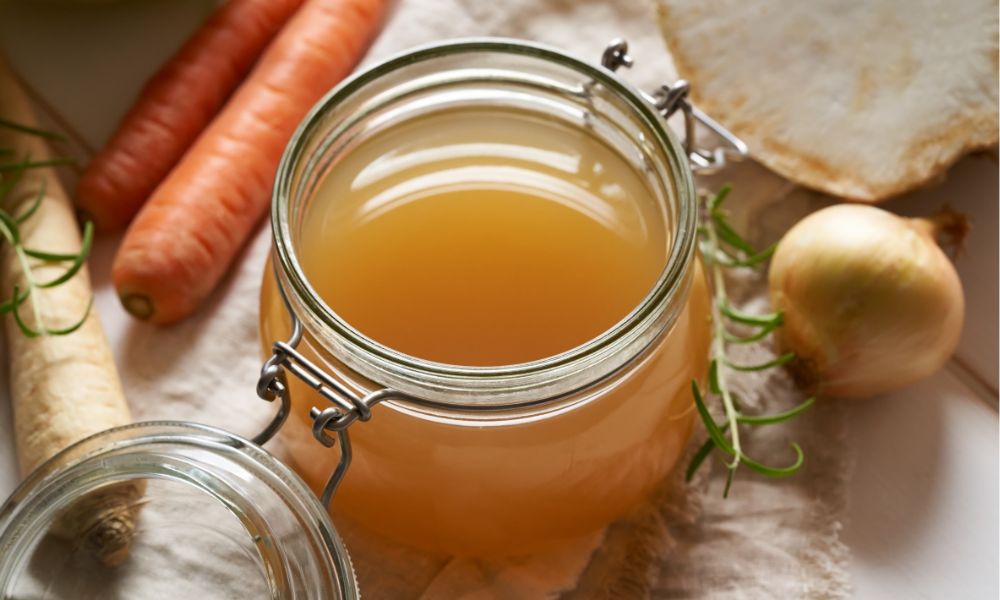Simple Bone Broth Recipe

Bone broth is the ultimate kitchen hack for turning leftovers into liquid gold. It takes time, but it's very low-effort and you can use it to give your recipes a slow-cooked homemade boost for weeks afterward. Thrifty and versatile, bone broth unlocks a world of possibilities for repurposing Thanksgiving leftovers into sensational meals. This timeless technique transforms unused bones into a flavorful elixir. Crafted with leftovers in mind, bone broth isn't just a culinary staple; it's a secret weapon for maximizing flavors and minimizing waste. Savor the rich, comforting essence of homemade bone broth—it's the low-cost staple ingredient your kitchen needs!
Ingredients:
- 2-3 pounds of leftover bones from a turkey, chicken, or beef roast. If using raw bones, you can roast them in the oven at 400°F (200°C) for about 30 minutes for added depth of flavor.
- 1 teaspoon olive oil or neutral cooking oil
- 2 tablespoons of apple cider vinegar (helps extract nutrients from the bones)
- Water (enough to cover the bones in the pot)
- Roughly chopped vegetables like carrots, onions, celery, garlic, and herbs like bay leaf, thyme, and parsley for added flavor. You can even use leftover bits like celery bottoms, carrot tops, mushroom stems, and well-cleaned vegetable peels.
- 1 Tbsp whole peppercorns
- Salt to taste
Instructions:
-
Prepare the Bones: Clean as much meat as you can from the bones and if necessary, separate the joints so the bones will fit in your pot. Soup stock can include joints, knuckles, bits of meat, and the bones themselves so don't worry too much about picking the bones absolutely clean.
-
Sear the bones: Heat the oil over medium-high heat in a large stockpot or slow cooker and add the bones. Cook for 4-6 minutes, turning to sear on all sides.
-
Brown the vegetables: If necessary, add a little more oil and the chopped vegetables with a generous sprinkle of salt. Cook for 5-8 minutes, stirring occasionally, until the vegetables are a little brown. You want the vegetables to caramelize a little bit because this will give you a richer, pleasantly browned broth at the end.
- Add the rest of the ingredients: Add the apple cider vinegar, herbs, and pepper and enough water to cover the bones. As you add the water, scrape up any browned bits that have stuck to the bottom of the pot. (That's the good stuff!)
-
Simmer: Turn on the heat to medium-high and slowly bring the pot to a gentle boil. Once it starts boiling, reduce the heat to low and let it simmer. Skim off any foam or impurities that rise to the surface.
- Simmer for Hours: Let the broth simmer for a minimum of 12 hours, but ideally up to 24-48 hours for maximum flavor and nutrient extraction. The longer it simmers, the richer and more flavorful the broth becomes. If you're pressed for time and have a pressure cooker, you can cook it at high pressure for only two hours. Patience pays off though, and the slower it's cooked the better. The key is gentle cooking.
-
Strain and Cool: Once the broth has simmered slowly for hours it should take on a rich, golden color. You can taste it as you go to see if it's flavorful enough or needs more time. Once it's done to your liking, strain it through a fine-mesh strainer to remove the bones and vegetables. Allow the broth to cool slightly. Taste for saltiness and add salt, if desired.
-
Store or Use: Store the bone broth in airtight containers in the refrigerator for up to a week or freeze it for longer storage. Use it as a base for soups, stews, sauces, or enjoy it on its own as a comforting and nutrient-rich drink.
Remember, bone broth is a very adaptable recipe; experiment and adjust the ingredients based on your flavor preferences and what you have in your leftovers! You could try hot peppers, mushrooms, ginger, or extra garlic -- bone broth is the choose-your-own adventure of kitchen basics. However, you'll want to steer clear of vegetables in the brassica family (such as broccoli, cauliflower, brussels sprouts, and cabbage) since they can give the broth a bitter flavor. Potatoes and squash also don't do much for stock, since they have a neutral taste on their own, they neither hurt nor enhance your bone broth.

